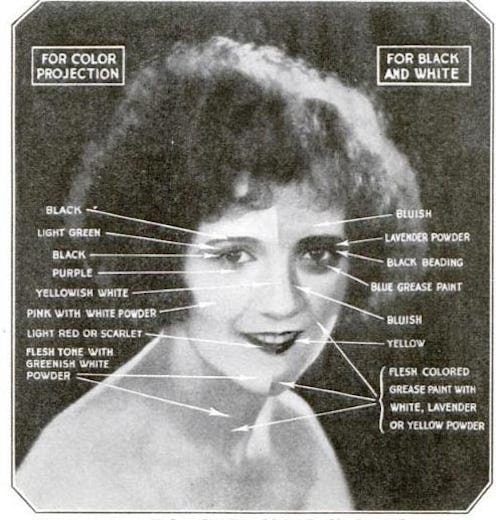
There are thousands of makeup tutorials out there on the interwebz that will teach you how to do your makeup like a flapper. Shades of plum, alabaster, rouge and liquid eyeliner are employed to achieve that “vintage look” established by our favorite silent film stars. I spent a spectacular Thursday painting my face according to how vintage film stars were directed to do their makeup. I looked less like Clara Bow, and more like a trippy muppet.
How, you ask, did I end up looking like a face-meld of Bebe Bluff and Skeeter, when I set out to look like a throwback starlet? Well, back in the pre-talkie days, actors and actresses needed to make themselves up in highly contrasting colors for their faces to look natural on camera. This was to compensate for a light sensitivity in the cheap kind of film stock that was the industry standard of the day. To that effect, actors painted their faces in blues, purples, and yellows so they would register on screen as human, and not Voldemort-esque monsters with nostril slits and no facial contours.
As my guide, I used this 20s vintage makeup tutorial which outlines the proper makeup to use for early black and white film. Try this at home if you feel so compelled, but don’t plan on leaving the house like this unless you’re going to a Brony convention and plan on dressing up. With that in mind, here’s what I did to look like an early black and white film star.
1. Check the blueprint.
I have nothing but this guide, the staff of Ricky’s, and my own gumption to shepherd me through this project. The look on the right is what I’m going for.
2. Regard your face as it naturally is.
This is my face without any makeup. If I showed up like this on a set in the 20s, no makeup, no hair, no wardrobe, the director would be like “Am-scray toots!”
2. Apply grease paint that matches your skin tone as a base for the following makeup shenanigans.
As per the tutorial, I put on grease paint matching my complexion. As a disclaimer, this is my first foray into using theatrical makeup or "grease paint." I was astounded at its effectiveness as a foundation. Here, I’m chipper and lively, ready to trade in my Bare Minerals for oil-based facial schmear.
3. Cake the top half of your head in blue grease paint.
Things are starting to get interesting… The guide calls for “bluish tones on the forehead, bluish on the cheeks, and blue under the eyes. On film, this is the first step to give your face dimension. In real life, you look like Smurfette’s child with a human male.
4. Gingerly powder your cheeks, chin, and eyelids in lavender.
Now here, I approximated the “lavender powder” as best as I could with purple and white powders mixed together. I applied the concoction to the apples of my cheeks, my chin, and my eyelids as prompted. Please, invite me to all of your parties.
5. Yellow lipstick, for the original duck face.
Yellow lipstick paired with purple blush and blue foundation may be a bit unorthodox by today’s beauty standards, but this was a surefire way to get lips to show up. Purple and blue read as variations of the same color in early film, but yellow is at the opposite side of the color wheel and definitely stood out. However, in living color, I have the pout of Marge Simpson.
6. Approximate “black beading” as best as you can, because the real thing could blind you.
The beauty guide calls for black beading on the eyelashes, to which my first reaction was “Guhh?? Beads on my eyes? Sounds dangerous!” Turns out, they’re not talking about literal beads, but hot beads of wax. Don’t get it twisted though, because it’s still horrifically dangerous. Starting in the 1910's, women employed this technique for a wet, quasi-spidery look. Basically, you’d cook brown or black wax cosmetic in a pan, then apply to your lashes. I wasn't trying to go to the hospital, so I subbed Vaseline and mascara in lieu of eyelash beading. The feeling can only be described as interesting.
7. Observe the final product.
Facial contours, lashes, lips and all, I’m ready for my close-up Mr. Demille. A list of things that I looked like at the end of this project include, but are not limited to:
- Someone who has held their breath for too long
- A blue man group reject
- A person infected with a hybrid of jaundice, hypertension, and hypothermia
- King Joffrey at the royal wedding
While this is not exactly every day beauty for you and I, for early film actors and actresses, this was a day at the office. So while you’re seeing this on screen in some black and white films…
The crew saw this in person...
Even the seemingly most real things in early film are not what they seem, just as it is today. Reality is socially constructed. Time is a flat circle and nothing is real. Rust Cohle was right all along.